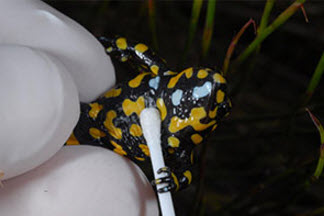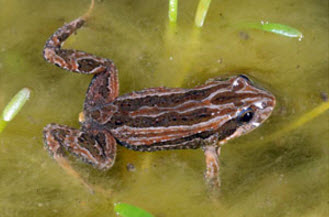Frog Fungus
The rapid decline of the Corroboree Frogs over the past three decades is the result of a disease known as chytridiomycosis, which is caused by infection with the amphibian chytrid fungus (Batrachochytrium dendrobatidis). A highly virulent strain of the amphibian chytrid fungus appears to have spread throughout the world over the past few decades, and has caused major declines and extinctions on every continent where amphibians occur. At this stage we are unsure where this pathogen originated.
In the Alps, the common Eastern Froglet (Crinia signifera) is a host for the fungus, and doesn’t appear to be susceptible to the disease. Common Eastern Froglet populations have remained high across the Australian Alps and they occur at all known Southern Corroboree frog sites, and the majority of Northern Corroboree Frog sites.

Swabbing Corroboree Frogs to detect presence of Chytrid Fungus

The common Eastern Froglet (Crinia signifera), which is the main reservoir for the the amphibian chytrid fungus in Corroboree Frog habitat
Habitat Degradation and Drought
While disease is the key factor causing the decline of Corroboree Frogs, other processes also contribute to the decline of these species or degradation of habitat. Because Corroboree Frogs typically breed in seasonal wetlands, severe droughts cause mortality of entire tadpole cohorts, contributing to the ongoing decline of the species. Prolonged periods of extreme drought, such as the millennium drought that occurred from 2003 to 2009, will also alter the structure and functioning of wetlands, resulting in reduced quality of breeding habitat for Corroboree Frogs.
Weeds and Feral Animals
Weeds and feral animals are also likely to significantly reduce the quality of breeding habitat for Corroboree Frogs. In recent years, feral pigs, feral horses, and samba deer have all been observed damaging Corroboree Frog breeding habitat by trampling wetlands. Because Corroboree Frogs typically breed in pools that are exposed to sunlight, shading by weeds such as blackberry is also likely to impact these species. Managing feral animals and weeds so that they don’t degrade wetland habitats is important for the future recovery of Corroboree Frogs.

Southern Corroboree Frog pool impacted by feral horses. The NSW National Parks and Wildlife Service removed horses from this area to protect Corroboree Frogs

